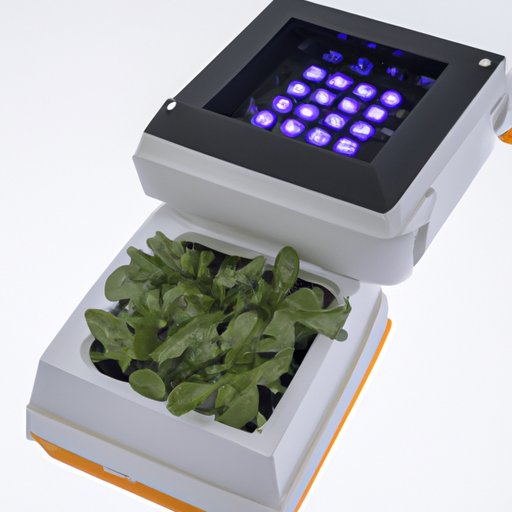Introduction
Indoor plants are a great way to add life and color to your home. But in order to get the most out of your plants, you’ll need to provide them with the right kind of light. That’s where grow lights come in. Grow lights are special types of lighting designed to simulate natural sunlight, allowing you to grow healthy and vibrant plants indoors.
In this article, we’ll take a look at how to use grow lights for indoor plants. We’ll cover the materials you’ll need, the different types of grow lights available, how to choose the right location for your lights, tips for optimizing light intensity and placement, the benefits of using grow lights, and troubleshooting common issues.
Step-by-Step Guide to Setting Up Grow Lights for Indoor Plants
Getting started with grow lights is easy. Here’s a step-by-step guide to setting up your lights:
1. Gather materials. You’ll need grow lights, a timer, an extension cord, and a power strip. If you’re using fluorescent lights, you’ll also need reflectors.
2. Choose a location. Pick a spot that’s close to a power outlet and away from drafts. Make sure there’s enough space between the lights and the plants so they don’t get too hot.
3. Install the lights. Hang the lights from the ceiling or mount them on a wall. Plug the lights into the power strip, then plug the power strip into the extension cord. Finally, plug the extension cord into the timer and turn it on.

Types of Grow Lights and Which Ones are Best for Your Indoor Plants
There are three main types of grow lights: fluorescent lights, LED lights, and high intensity discharge (HID) lights. Each type has its own advantages and disadvantages.
Fluorescent lights. Fluorescent lights are the most affordable option. They produce a soft, diffuse light that’s ideal for seedlings and young plants. However, they’re not as bright as other types of lights and they don’t last as long.
LED lights. LED lights are more expensive than fluorescent lights, but they’re more efficient and they last longer. They emit a bright, focused light that’s perfect for mature plants.
High intensity discharge (HID) lights. HID lights are the brightest and most powerful type of grow light. They’re ideal for larger plants and for covering large areas. However, they’re also the most expensive option.

How to Choose the Right Location for Your Grow Lights
When choosing a location for your grow lights, there are a few things to consider:
Consider the size of your space. Make sure the lights won’t be too close together or too far apart.
Calculate the amount of light needed. Different plants require different amounts of light. Do some research to find out how much light your plants need.
Position the lights correctly. Place the lights above the plants, not behind them. This will ensure they get the maximum amount of light.

Tips for Optimizing Light Intensity and Placement for Indoor Plants
Once you’ve set up your lights, there are a few things you can do to optimize their performance:
Increase the distance between plants and light sources. The closer the plants are to the lights, the more intense the light will be.
Utilize reflective surfaces. Mirrors and other reflective surfaces can help to increase the amount of light reaching your plants.
Maximize natural light. If possible, position your plants near windows to take advantage of natural sunlight.
Benefits of Using Grow Lights for Indoor Plants
Using grow lights for indoor plants has many benefits, including:
Improved plant health. Grow lights provide just the right amount of light for optimal plant growth.
Extended growing season. With the right setup, you can extend the growing season for your plants.
Increased yield. By providing the right amount of light, you can increase the yield of your plants.
Troubleshooting Common Issues with Grow Lights for Indoor Plants
If you’re having trouble with your grow lights, here are some common issues and how to fix them:
Lights burning out too quickly. This can be caused by too much heat or too little ventilation. Make sure the lights are positioned properly and the area is well ventilated.
Too much heat being generated. Again, make sure the lights are positioned properly and the area is well ventilated. Consider using fans to circulate air if necessary.
Poor distribution of light. Make sure the lights are positioned correctly and that the reflectors are angled correctly.
Conclusion
Grow lights are a great way to get the most out of your indoor plants. With the right setup, you can ensure your plants get the light they need to thrive. By following the steps outlined in this article, you can easily set up grow lights for your indoor plants and enjoy the benefits of healthier, more abundant plants.


